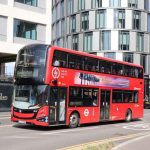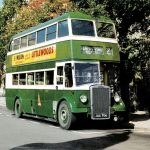As post-pandemic traffic volume grows, bus operators share how work with local authorities hopes to abate the effects of a car-based recovery. Is there still a chance?
The TomTom traffic index ranking, which tracks urban congestion in 416 cities across 57 countries, provided stark evidence of how the pandemic affected global traffic levels in 2020. Lockdown, working from home and “an exodus” from many of the world’s capital cities prompted optimistic conversations on how the pandemic could affect a global shift in mobility.
Will there be a happy ending to those conversations? Growing problems of congestion were recently highlighted to routeone by Mark Carver of Carver’s Coaches, who reports that congestion levels on certain Fridays has worsened to the point that an hour’s leeway is needed to ensure vehicles can return on time – an amount Mark admits is simply “not physically practical”.
More operators have since revealed a growing picture of worsening congestion across the UK, with a car-based recovery looking likely as traffic volumes beat patronage recovery and service delivery is affected. But with the potential for Bus Service Improvement Plans (BSIPs) to make meaningful change to how cities favour certain modes, is there still time to take action?
Tackling a long-term problem
One location to consistently feature in the top 10 list of worst congested cities in the traffic index ranking is the Bournemouth, Christchurch and Poole (BCP) area. In 2020 it scored sixth place, more congested than Manchester, Glasgow and Leeds, despite traffic volumes being down some 26% from 2019 levels.
For David Squire, Managing Director of Yellow Buses, this has consistently been a barrier not just to running punctual bus services, but also to the area’s economic prosperity. That’s why the operator majored on the problems brought by congestion in the BSIP agreed with the local authority.
When David arrived in the company some four years ago, Yellow Buses was scheduling services at 14mph, which brought with it punctuality issues. In subsequent changes, it now schedules at 12mph with firebreak-style schedules after the morning peak and on some routes in the afternoon. That means timetable departures sit back to allow things to recover when problems arise. That has improved punctuality, but means services are slower. It’s an issue David says the operator can get on top of, but only for a time.
He now believes that congestion levels seem worse than they were in the run-up to the pandemic. He puts that down to continued government messaging to avoid bus travel during COVID-19. Combined with roadworks, this has increased journey times. “The main corridors that we operate along have suffered, in particular in September when schools and colleges returned. That has had a knock-on effect on services that wasn’t there prior to the pandemic.”
 In contrast, patronage on Yellow Buses rose to 78% of pre-pandemic levels in the second week of September with the return of schools and colleges. But that has tailed off in the last few weeks, a blow to good patronage growth prior to the pandemic. “It varies by route, but percentage averages across the network are into the low 70s and high 60s. That may be due to the increased numbers of COVID-19 cases and reluctance to travel. In Dorset, case prevalence is higher than UK averages.”
In contrast, patronage on Yellow Buses rose to 78% of pre-pandemic levels in the second week of September with the return of schools and colleges. But that has tailed off in the last few weeks, a blow to good patronage growth prior to the pandemic. “It varies by route, but percentage averages across the network are into the low 70s and high 60s. That may be due to the increased numbers of COVID-19 cases and reluctance to travel. In Dorset, case prevalence is higher than UK averages.”
To try to counteract delays brought by congestion, interworking of services was ended and vehicles are scheduled to one route only. That means localised congestion on one service no longer affects the rest of the network.
Additional fleet capacity is of course not practical when passenger numbers are not there to support it, so the operator is running services at a frequency catering for as many passengers as possible on time as much as is practical. David believes that when interventions increase punctuality, it gives passengers more confidence in services.
“It might be slower, but if the bus turns up at the time we say it will turn up at, people will use it. At the end of the day, we have to deal with the pack of cards that we’ve got.
“The services which we found had the worst punctuality were also the ones not performing in terms of customer numbers. By tackling those services, you can stabilise the loss and start to grow them again as people get used to it being a slower but more reliable service.”
In terms of the BSIP submitted at the end of October, roundtable discussions with political leaders and BCP’s other principal operator came up with a package of measures which will hopefully make buses more reliable and punctual. It aims to deal with congestion issues through ambitious end-to-end bus corridor and priority improvement, a parking strategy and traffic signal priority, and better traffic enforcement.

Cars: Still favoured?
Where car users are being favoured by government, frustration often follows. A decision by the Scottish Government to permanently remove hospital car parking charges in Dundee’s Ninewells Hospital, Glasgow Royal Infirmary and Edinburgh Royal Infirmary in August has been described as “disastrous” to bus patronage recovery and congestion levels by one operator. This comes as Edinburgh tops TomTom’s traffic index ranking list as of 2020.
Parking charges at each of the hospitals were suspended at the start of the pandemic, but the permanent scrappage of charges alongside messaging to avoid bus travel has been a blow to bus operators in the region. The deals at Glasgow Royal Infirmary and Ninewells are reported to have cost £26.3m and £9m respectively, with Edinburgh talks in an advanced stage.
“It’s a double whammy,” says Managing Director of Prentice of Haddington Ross Prentice. “That decision meant we lost a lot of the staff and patients we used to take into hospital. At the same time, the numbers of staff and patients is so high that the congestion on Edinburgh Road in Musselburgh is unbelievable now. It never used to be an issue at all.”
While Prentice of Haddington has limited delays to around five minutes by using a back route, it has been reported that buses using the orbital route around Edinburgh are now experiencing delays of some 30-40 minutes. The result is increasing bitterness in government messaging.
“COVID has had a lot to do with it,” Ross says, “but the message from government not to use public transport has been the only excuse people need to return back to cars. Now, there seems to be more congestion at times and in certain places than we saw pre-pandemic.”

The cost of congestion
The financial impact of long-term growing congestion on bus services and patronage was outlined recently by Oxford Bus Company (OBC) Managing Director Phil Southall.
Data showed how running speeds on all main corridors in Oxford worsened between 2015 and 2018 due to congestion, with as much as a 30% reduction in bus speeds on Abingdon Road. To counteract its effects, the operator looked at frequency reduction and extra resource to maintain frequencies. On OBC’s busiest service, two additional buses have been added in the last nine years.
Nine buses working a 72-minute cycle has now become 11 buses working an 88-minute cycle. This has had an impact of an average £183,000 per annum per peak vehicle added to the network. That means an additional £366,000 per annum to run the same frequency on just one service. That additional cost has been absorbed by the operator rather than being passed on to customers, to avoid driving passengers away and worsening the situation further.
The challenge has been made greater by the pandemic, according to Phil. Car volume in Oxford now stands at approximately 95% of pre-pandemic levels while bus patronage and revenue remain depressed.
There has been a pronounced loss of commuters on park and ride services (60% of pre-pandemic patronage), long-distance coach services to London (40% of pre-COVID volumes) and city services (70% of pre-pandemic volumes).

The fact that traffic volume is still below pre-pandemic levels indicates there are other factors involved. In Oxford, roadworks play their part. “Since the lockdown was eased in the early part of 2021, congestion has now increased so that it is only 3% off pre-pandemic levels,” says Phil. “The impact of that is that punctuality has gone from over 95% during the lockdown to, at our latest stage, only 78%. We’re continuing to work with Oxfordshire County Council to try and mitigate the impact of roadworks and growing traffic.”
One problem, Phil argues, is a disconnect between strategy teams and the network management teams within government. “What is required is the network management teams to be brought more closely into the strategy of the county council and to manage the impacts of roadworks much better.
“Politicians don’t want to be seen to penalise car traffic and promote bus traffic above general traffic. In Oxford there is a clear mandate to try and do that, but the network management team feels it can’t. We need to get the political voice louder to prioritise buses.”
That is what the Oxford BSIP is now trying to do. Proposals are to introduce Connecting Oxford, a package of measures which will include traffic filters outside the city centre and a workplace parking levy to give buses free-flow conditions across the city.

Still room for hope?
One industry figure feeling optimistic despite local road
traffic volumes being in excess of 90% of pre-pandemic levels
is Nottingham City Transport Managing Director David Astill.
“Pre-pandemic we were adjusting services on a regular basis.
Traffic volumes are ahead of public transport patronage, but
they are not back to 2019 levels yet,” he says. “One of the
positive impacts of that is we still have good bus punctuality.
The downside of that is that not all our customers are seeing
the benefit, because they’re not all travelling with us.”
NCT’s busiest period this year was in September, where
punctuality levels still hit 95%. In the same period in 2019,
punctuality was down to 86%. Roadworks played a huge
part in that, with the closure of the eastbound carriageway
of Clifton Bridge. That period saw Nottingham as the most
congested city in the world on the TomTom traffic index
ranking.
NCT shares that punctuality data with the local authority,
but there are signs that Nottingham City Council continues
to favour cars to the detriment of public transport providers.
Broadmarsh, the council’s investment in a new city centre
multi-story car park as part of a redevelopment plan, opened
on November 1. A two week offer of £5 per day parking
is clearly designed to encourage motorists into the city.
“I don’t want to make a big thing out of it, but that’s just
another challenge that Nottingham’s bus operators are faced
with at the current time,” David says. This comes as car
park occupancy levels as reported by the Victoria Centre
in Nottingham are also in excess of 90%. NCT’s bus patronage,
conversely, stands at around 75% of pre-pandemic levels.
But David counters this with optimism that a return to 2019
traffic levels may not be as imminent as in some other areas.
“I am concerned about trends, but I’m also optimistic,” he says.
“I think it’s a two-year process to get back to 2019 levels.
We are in recovery, and it’s about being realistic about the
timescale of that recovery period. It’s not a quick fix.”























